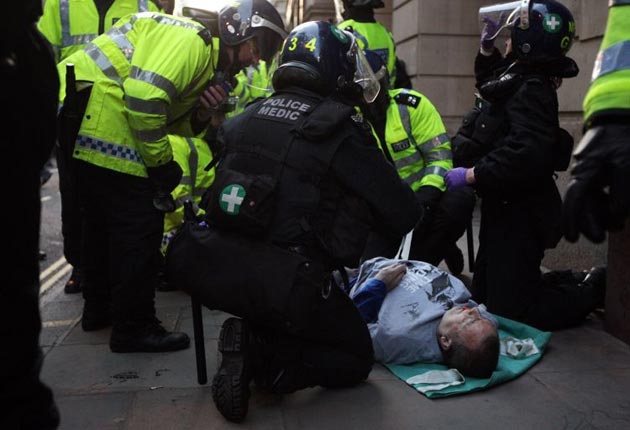G20 Ian Tomlinson death police made baton query

Police queried whether a baton caused Ian Tomlinson's injuries four days before video showing an officer striking him was made public, an inquest heard today.
The senior detective leading the investigation into the newspaper seller's death during the G20 protests two years ago also questioned whether he was bitten by a dog.
Officers asked the first pathologist who looked at Mr Tomlinson's body to determine whether he was assaulted or crushed by crowds, the hearing was told.
Dr Freddy Patel was initially asked to perform a standard post-mortem examination on the 47-year-old newspaper seller after his death on the fringes of the demonstrations in central London on April 1 2009, the inquest heard.
But police upgraded this to a more detailed forensic post-mortem and told the pathologist that broken glass bottles and protesters' sticks were found around his body.
Detective Superintendent Tony Crampton, the City of London Police officer leading the inquiry, attended the post-mortem examination on April 3 and asked Dr Patel about specific marks on the body.
In particular, he quizzed the pathologist about what caused a large "tramline" bruise on Mr Tomlinson's left leg.
Alison Hewitt, counsel to the inquest, asked Dr Patel: "Do you recall Detective Superintendent Crampton asking you whether that injury could have been as a result of a baton strike?
"Did you say to him at the time that you could not rule that out but you thought it was more likely to have been as a result of falling against something?"
Dr Patel replied: "If I remember correctly, what I said was that, as you say, I can't rule it out, but it's in keeping with contact with or from, against a linear object."
It was not until April 7 that amateur video emerged of Metropolitan Police officer Pc Simon Harwood striking Mr Tomlinson with his baton before shoving him to the ground.
Mr Crampton also asked whether puncture wounds on Mr Tomlinson's right leg might have been caused by a dog bite, the inquest heard.
Dr Patel told the hearing: "I explained to him that they weren't typical of a dog bite.
"I was told that there were a lot of broken bottles thrown there, so I said it could also have been caused by contact against a rugged sharp object."
Pc Harwood earlier told the inquest that Mr Tomlinson was seen being bitten by a police dog during the G20 protests.
Dr Patel said he queried why detectives decided he should carry out a forensic post-mortem examination on Mr Tomlinson.
"I would have been informed by the coroner's officer that they would like to rule out he had suffered any injuries as a result of an assault - and there was a big crowd there, whether he suffered any crush injuries related to the protesters in the public disorder," he said.
Before carrying out his examination, Dr Patel was told that Mr Tomlinson, who was born in Matlock, Derbyshire, was an alcoholic with a series of medical complaints who had slept rough for 20 years.
He found the death was consistent with natural causes because the newspaper seller had coronary artery disease and could have died at any time.
But another two pathologists, Dr Nat Cary and Dr Kenneth Shorrock, later carried out their own post-mortem examinations and came to a different conclusion, the inquest jury has heard.
Dr Cary suggested that Mr Tomlinson could have been pushed so he fell with his right arm trapped under his body, hitting his liver and causing it to bleed internally.
Dr Patel told the inquest he found about three litres (5.3 pints) of fluid in the newspaper seller's abdomen, which he decided was a mixture of blood and a liquid called ascites produced by liver disease.
This abdominal fluid was thrown away before the other pathologists raised questions about how Mr Tomlinson died, the inquest heard.
Dr Patel said: "I didn't see it being discarded but then when the issue arose about the cause of death, I went back to the mortuary to ask where is that sample, and it wasn't in the mortuary. So it can only mean it was discarded."
The pathologist was asked whether he found evidence during his post-mortem examination that showed Mr Tomlinson must have died from coronary artery disease.
Dr Patel replied: "Partly that diagnosis is made on the basis there is no alternate explanation at the time of my examination to explain death."
Questioned why he ruled out internal bleeding as the cause of Mr Tomlinson death, he added: "There was no major injury to any organs or blood vessels that could produce in a short period of time sufficient bleeding to cause death."
The inquest at the International Dispute Resolution Centre in Fleet Street, London, was adjourned until tomorrow, when Dr Patel will continue giving evidence.
Bookmark popover
Removed from bookmarks